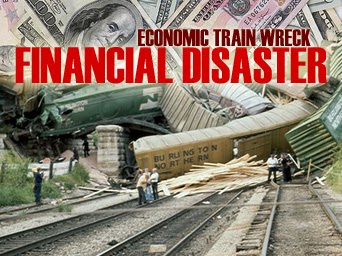| Online: | |
| Visits: | |
| Stories: |

| Story Views | |
| Now: | |
| Last Hour: | |
| Last 24 Hours: | |
| Total: | |
The Economy: “Why the Crowd Is About to Get Destroyed in US Stocks”
Wednesday, February 26, 2014 12:10
% of readers think this story is Fact. Add your two cents.
“Why the Crowd Is About to Get Destroyed in US Stocks”
by Bill Bonner
Dow down a bit yesterday. Gold up a bit. The upward trend of US stocks – and now gold – has not yet been broken. Looking broadly at major trends of the last 50 years, debt was the name of the game from 1980 to 2007. Is it still the most important thing?
From about 160% of GDP in 1980, total debt in the US rose to about 360%. That was a big deal. Not the least because it meant that US businesses availed trillions of dollars in income with no offsetting labor charge. Stocks, earnings, GDP, employment – with all this borrowed money flowing into the economy, the whole shebang looked good.
Dr. Jekyll, Meet Mr. Hyde: As we’ve been saying, debt may be the kindly Dr. Jekyll when it is expanding. But it becomes maniacal when it contracts. Mr. Hyde showed up in 2008, and the party was over. The US went into a debt contraction. We’ve been living with it ever since. Until the last quarter of last year, the private sector was either paying down or defaulting on its debt. But since 2008, we’ve also lived with ambiguity, split personalities and confusion. As households and businesses deleveraged, Washington leveraged up. The feds added nearly $7 trillion in debt after 2007. Overall, debt to GDP shrank… but not much. The tally fell from 360% of GDP down to 345%.
Deleveraging was the market’s natural reaction to excess debt. QE was the unnatural and monstrous response of the Fed. It expanded its balance sheet to reach a staggering $4 trillion, as it tried desperately to keep the EZ credit flowing.
From a recent Bank of America Merrill Lynch research report: “The US Fed’s modus operandi worked through asset prices, and animal spirits. This involved getting stock prices up, getting corporate animal spirits up by issuing cheap debt, buying back stock with cash orcheap debt to raise EPS, lowering government borrowing and mortgage costs, and raising consumer net worth/income ratios. Also, asset bubbles were generated in emerging markets, raising their growthlabor costs and currencies.”
Sharp operators followed the Fed like vultures trailing a sick cow. They borrowed at the Fed’s ultra-low rates… and bought stocks, real estate, contemporary art and emerging market debt. Anything that promised a higher yield than was available in the Treasury market.
Monetary Mambo: QE has been the name of the game since 2008. But QE helped Wall Street, not Main Street. Just look at charts of shipping indexes, real wages or the velocity of money. You see lines that head down in 2008… and don’t come back up.
In recent Diary entries, we’ve focused on two factors that weigh heavily on the economy: debt and demography. And we warned that these two factors will weigh heavily on US stocks prices. But we also noticed a possible spoiler – no prediction based on history has ever included the effects of QE or Janet Yellen! Eventually, everything normalizes. Eventually, we will almost certainly be right about stock market performance. But eventually can still be a long way into the future.
Which brings us to our updated, revised, and improved outlook: Remember our prediction six years ago? “Tokyo, then Buenos Aires,” we said. The idea was that the US economy would stay in deleveraging mode for “7 to 10 years”… and then, it would be off to the races. We suspected that the feds would get tired of Tokyo. We figured they’d be ready for some Latin-style action – a little central bank salsa… a bit of monetary mambo. We predicted that QE wouldn’t work… and that the Fed would want to be more activist – probably by giving up on QE and directly intervening in the money supply (which it is currently constrained from doing; the effects of QE are limited to boosting only the monetary base).
So, what have we learned in the last six years? How has our view changed? The answer to both questions is “not much.” As we guessed, an aging, deeply indebted, zombie-ridden economy will not improve by adding more debt. Instead, it is doomed to follow Japan down that long, lonesome road of low consumer prices, low growth and high debt. This road leads to eventual destruction. But when? And how?
In the US, as in Japan, QE does not help stimulate a real recovery. But it does help simulate one. House prices are up (thanks, in part, to ultra-low mortgage rates). The middle class has more “wealth” (albeit the paper kind) due to gains in their stock market portfolios. The rich are feeling fat and sassy, too.
The Fed can continue modest tapering. But this is likely to produce a selloff in the stock market. Then the Fed will stop tapering. But it will be too late to reverse the damage to equities. They will go down for many years… bringing us even closer to the Japanese model.
Our guess now is that this situation will persist for a few years. As long as the pain is tolerable, the Fed will not be so bold as to abandon QE or take up more daring measures. Tokyo today. Tokyo tomorrow. After tomorrow… we’ll see.”
- http://www.thedailyreckoning.com
Source: http://coyoteprime-runningcauseicantfly.blogspot.com/2014/02/the-economy-why-crowd-is-about-to-get.html




